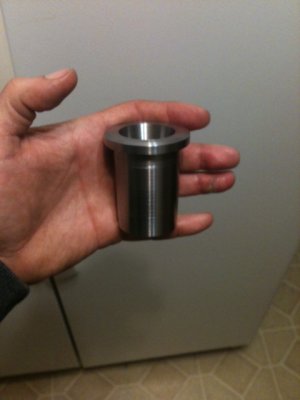- Joined
- Nov 16, 2012
- Messages
- 5,596
OK, I needed to make myself another MT5 to 5C taper adapter and another member needed one as well so here it is. Very easy to make but it's best if you draw it out first.
Here's a cross-sectional view as well as the dimensions for a spindle that has 1.5" diameter bore at the mouth. These dimensions won't work in a PM1236 machine. The adapters are custom sized depending on your spindle bore diameter. The MT5 angle is the same but the overall dimensions are different.
View attachment MT5_5C_Adapter-dims.pdf
View attachment MT5_5C_Adapter-sv.pdf
The one I made is slightly different than the drawn plans because the piece of stock I had on-hand was slightly less in diameter than what I thought. Also, I made the collar a little bit wider. These are inconsequential modifications. It's made of 1045 and I'll heat treat it this weekend. Here's a play-by-play:
First, the outer OD was turned to maximum size. This one is just shy of the 1.8" I planned to make it since the starting shaft was 1.75". I just made one pass on the outside to get the scale off. Not show here but, I bored a 1" hole down the center then did a precision bore to 1.260". The maximum main shaft dimension of a 5C collet is 1.25" so I gave a little clearance.
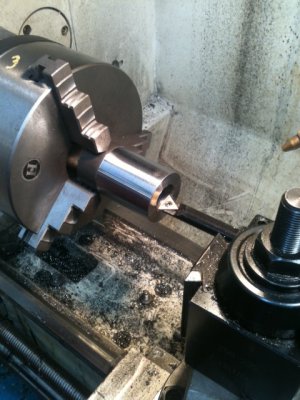
Next, the compound was set for 10[SUP]o[/SUP] (corresponding to the 5C spec) and the inner taper was opened up to the spec show in the diagram (which I believe is 1.475").
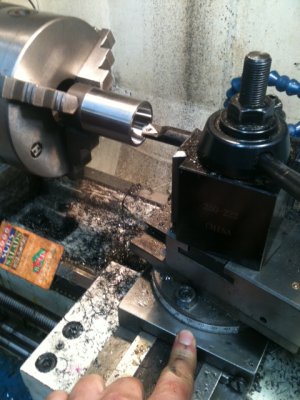
After that, the compound was set to 1.5073[SUP]o[/SUP]. The angel was carefully set by using travel indicators and measuring rise over run. The angle was then cut on the outside of the adapter. I measured-off from the front of the adapter, where the taper should end. In about 3-4 passes, the taper was cut from right to left.
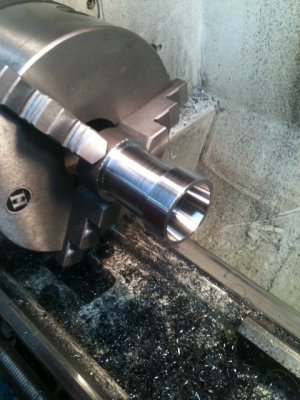
Basically done... Just part it off.
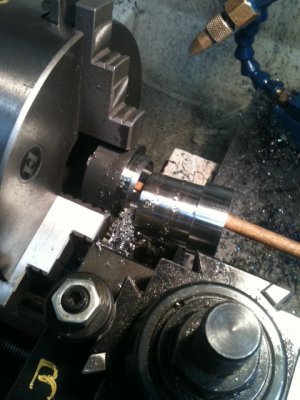
And here's what it looks like...
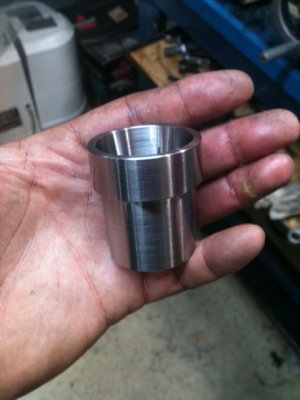
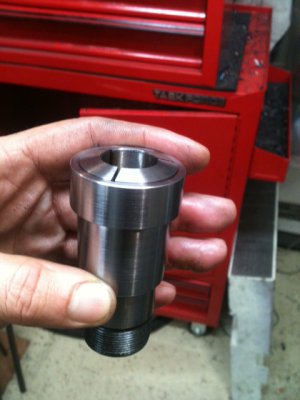
I'll heat treat it this weekend.
Ray






Here's a cross-sectional view as well as the dimensions for a spindle that has 1.5" diameter bore at the mouth. These dimensions won't work in a PM1236 machine. The adapters are custom sized depending on your spindle bore diameter. The MT5 angle is the same but the overall dimensions are different.
View attachment MT5_5C_Adapter-dims.pdf
View attachment MT5_5C_Adapter-sv.pdf
The one I made is slightly different than the drawn plans because the piece of stock I had on-hand was slightly less in diameter than what I thought. Also, I made the collar a little bit wider. These are inconsequential modifications. It's made of 1045 and I'll heat treat it this weekend. Here's a play-by-play:
First, the outer OD was turned to maximum size. This one is just shy of the 1.8" I planned to make it since the starting shaft was 1.75". I just made one pass on the outside to get the scale off. Not show here but, I bored a 1" hole down the center then did a precision bore to 1.260". The maximum main shaft dimension of a 5C collet is 1.25" so I gave a little clearance.

Next, the compound was set for 10[SUP]o[/SUP] (corresponding to the 5C spec) and the inner taper was opened up to the spec show in the diagram (which I believe is 1.475").

After that, the compound was set to 1.5073[SUP]o[/SUP]. The angel was carefully set by using travel indicators and measuring rise over run. The angle was then cut on the outside of the adapter. I measured-off from the front of the adapter, where the taper should end. In about 3-4 passes, the taper was cut from right to left.

Basically done... Just part it off.

And here's what it looks like...


I'll heat treat it this weekend.
Ray








